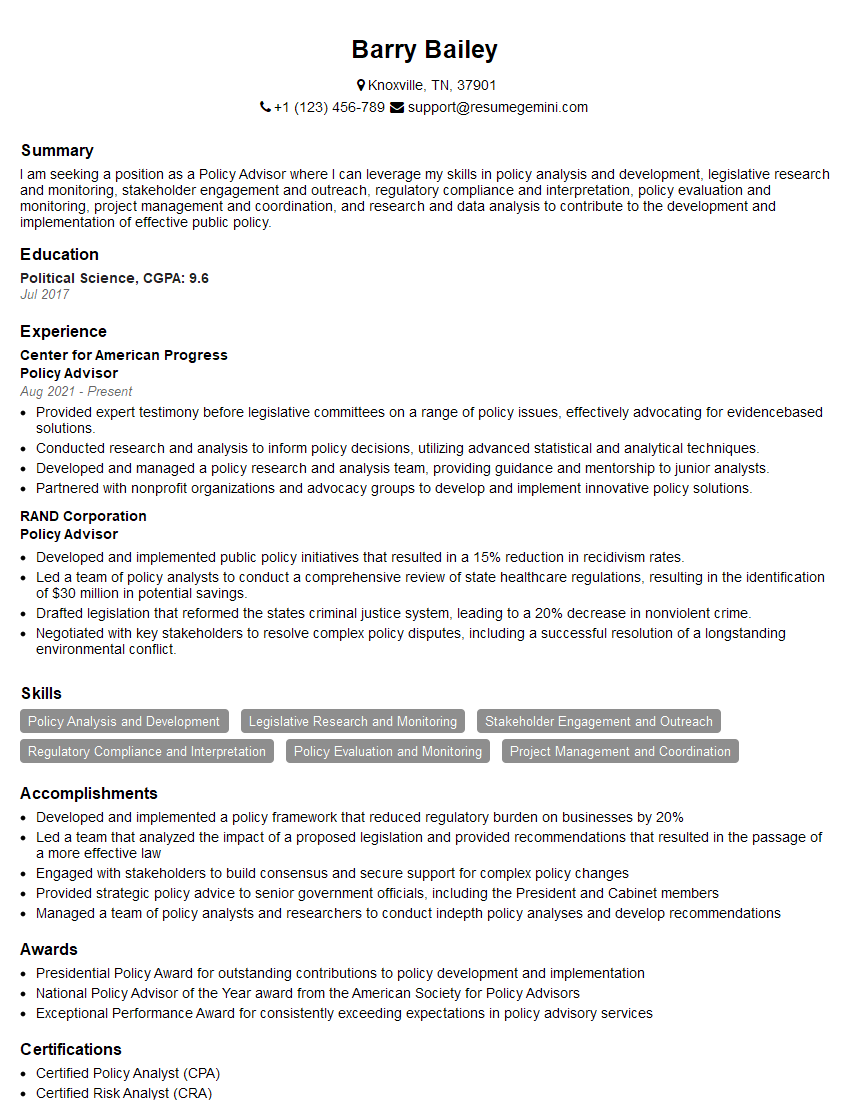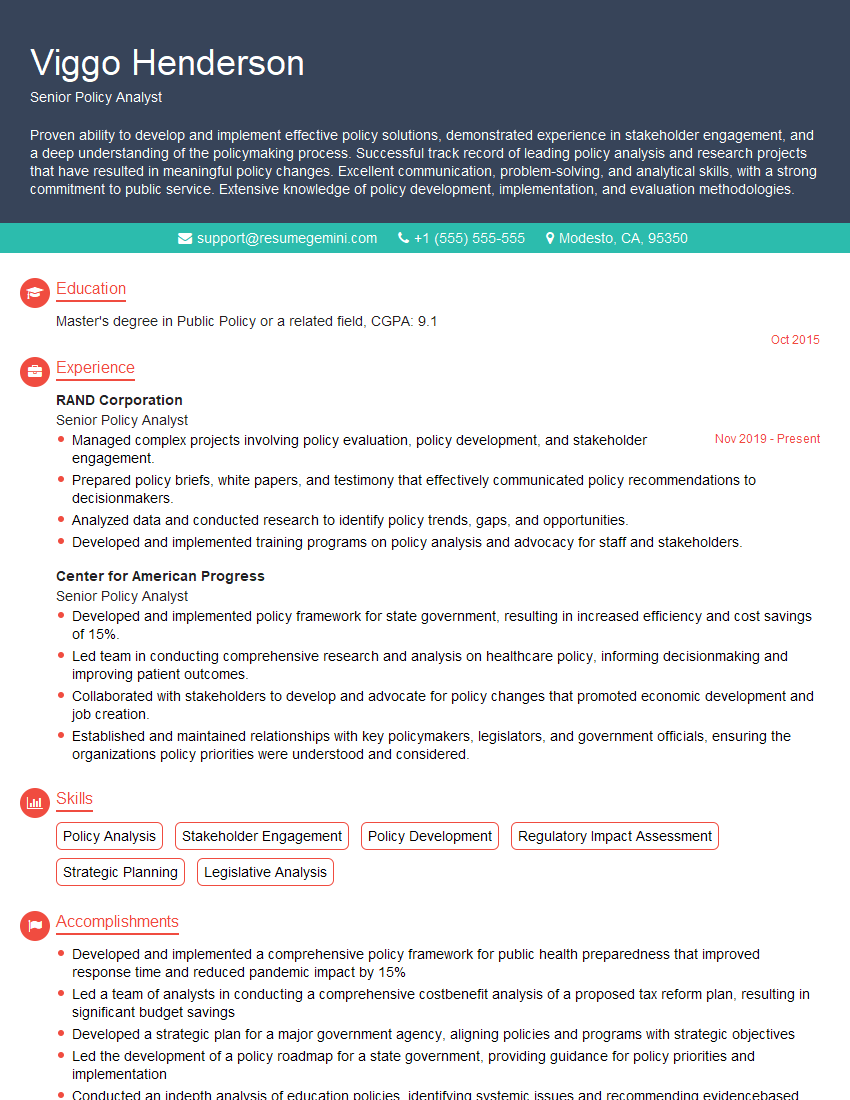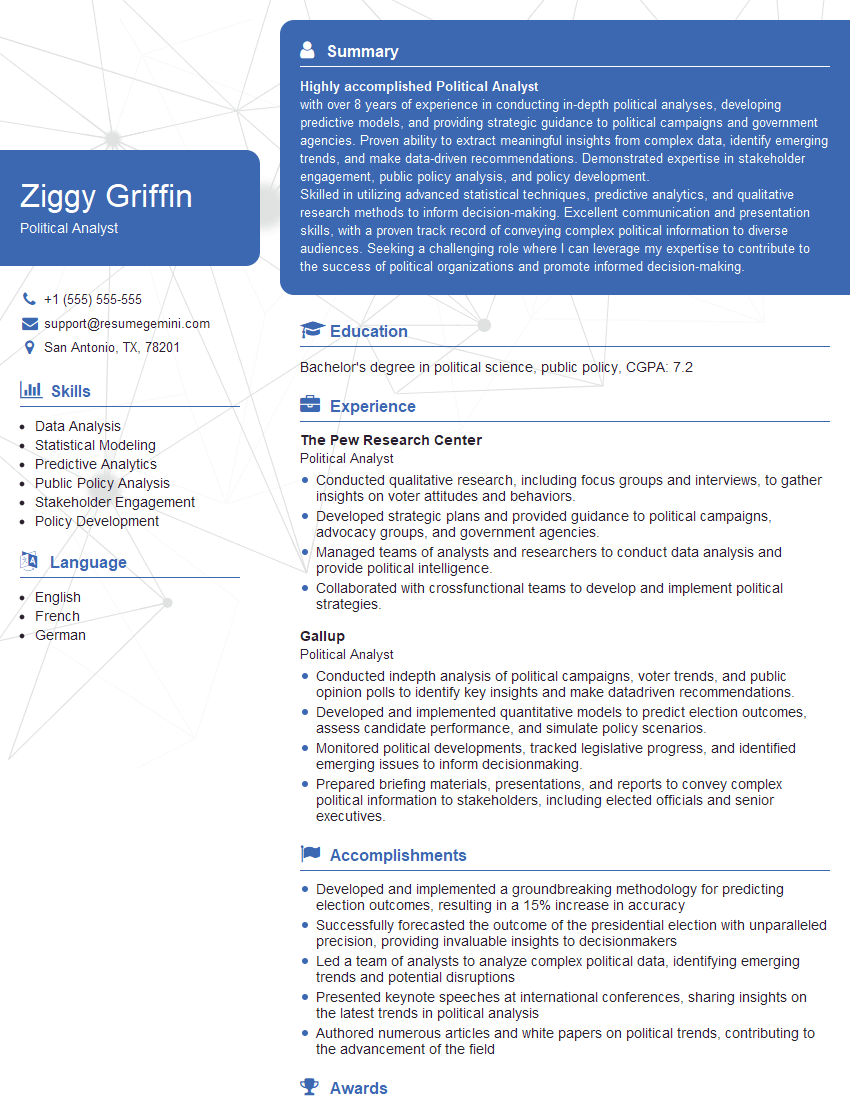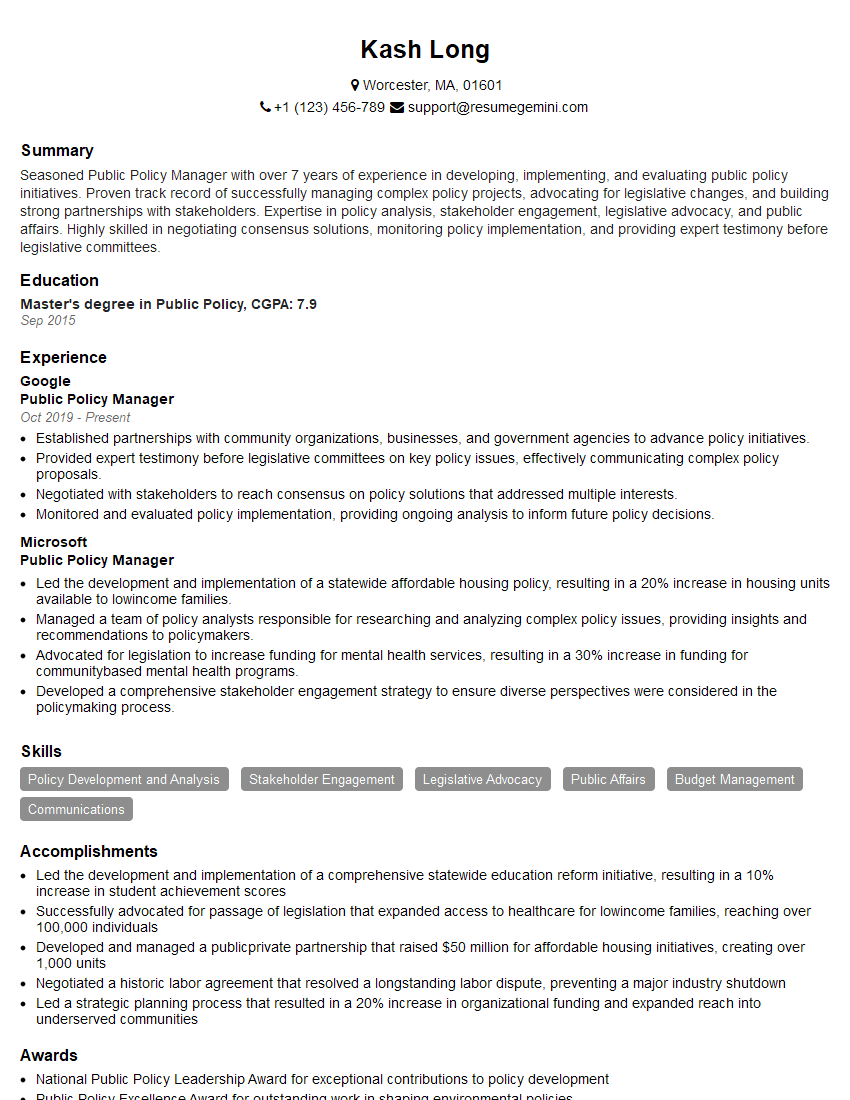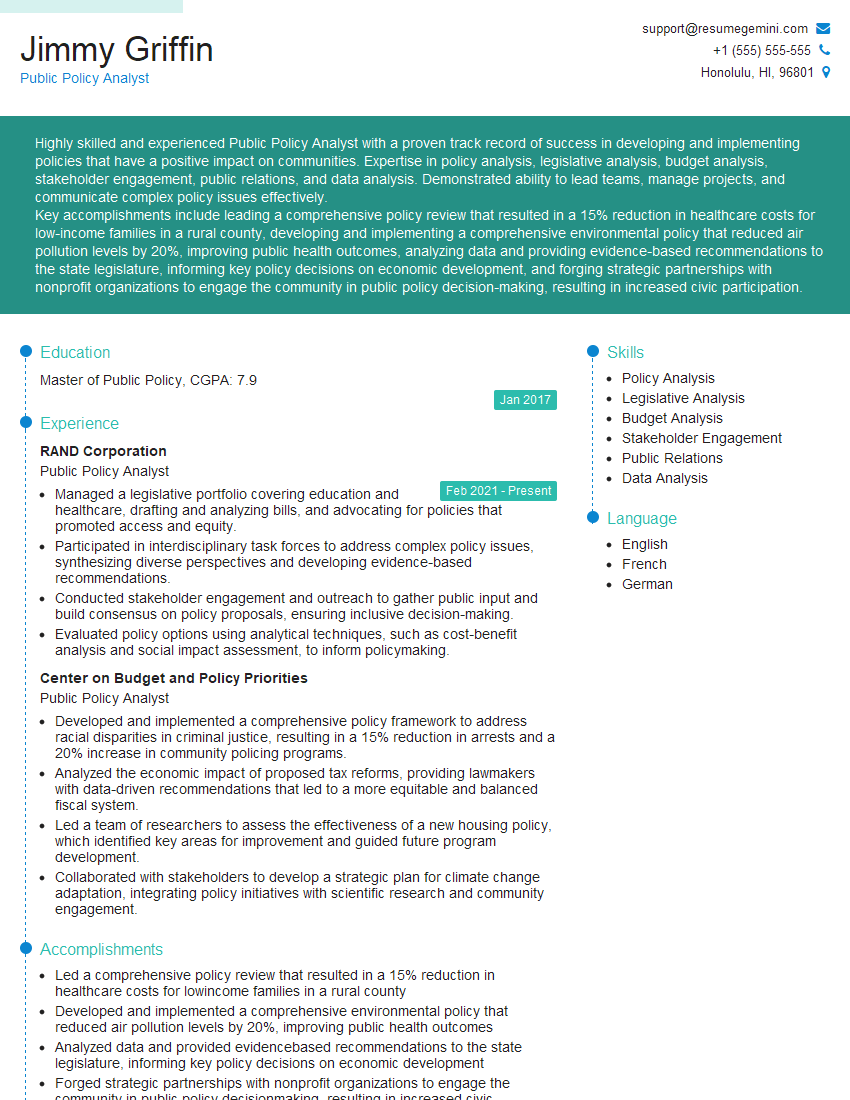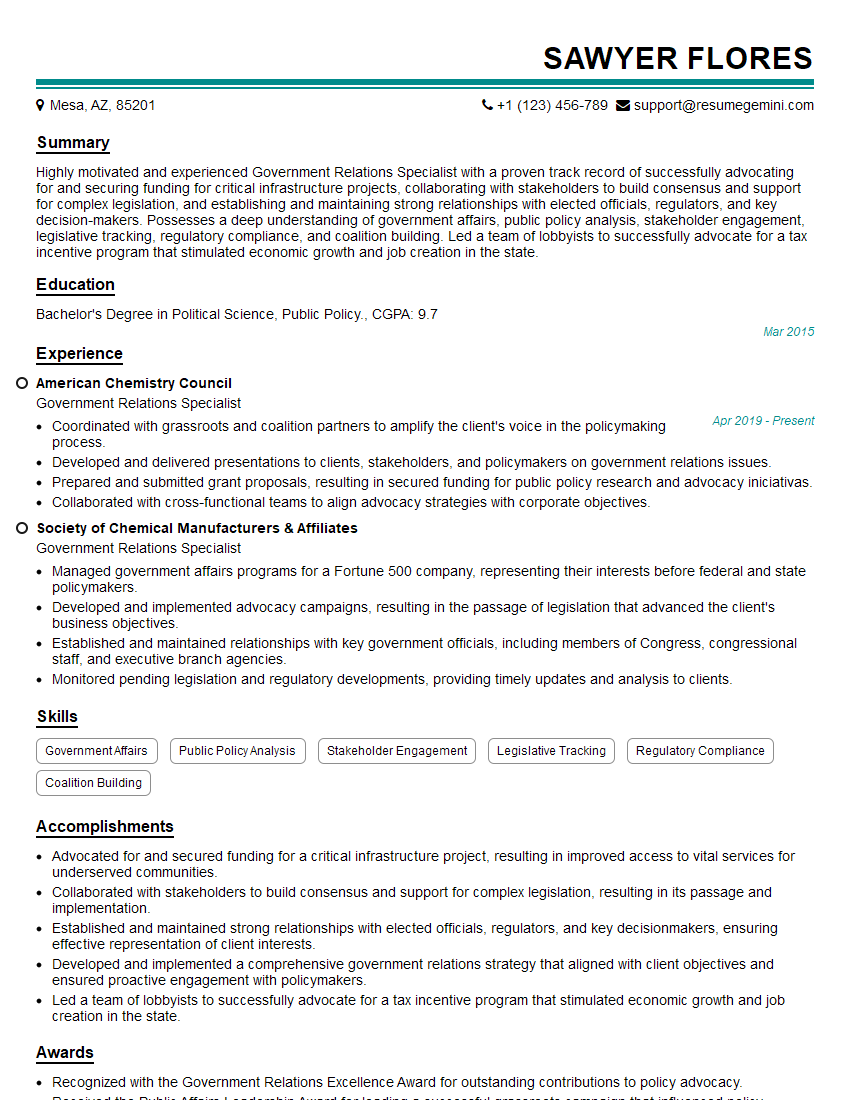Are you ready to stand out in your next interview? Understanding and preparing for Public Policy and Government Relations interview questions is a game-changer. In this blog, we’ve compiled key questions and expert advice to help you showcase your skills with confidence and precision. Let’s get started on your journey to acing the interview.
Questions Asked in Public Policy and Government Relations Interview
Q 1. Explain the difference between public policy and public administration.
Public policy and public administration are closely related but distinct concepts. Think of it like this: public policy is the ‘what’ and public administration is the ‘how’.
Public policy refers to the overarching goals, principles, and actions a government takes to address societal problems or achieve specific objectives. These are often expressed in laws, regulations, and executive orders. Examples include environmental protection policies, healthcare reform, or economic stimulus packages. These policies define the desired outcomes.
Public administration, on the other hand, is the process of implementing and managing those policies. It’s the ‘doing’ – the day-to-day work of government agencies and officials responsible for putting policies into effect. This involves budgeting, staffing, program design, performance evaluation, and ensuring accountability. For instance, the Environmental Protection Agency (EPA) administers environmental protection policies by setting emission standards, conducting environmental impact assessments, and enforcing regulations.
In short, policy sets the direction; administration executes the plan.
Q 2. Describe your experience with policy analysis techniques (e.g., cost-benefit analysis).
I have extensive experience employing various policy analysis techniques, most notably cost-benefit analysis (CBA). CBA is a systematic approach to evaluating the economic efficiency of a policy by comparing the total costs to the total benefits. It involves identifying all relevant costs and benefits, quantifying them (often in monetary terms), and then comparing the net present value (NPV) of the policy. If the NPV is positive, the policy is considered economically efficient.
For example, in a recent project analyzing the impact of a proposed highway expansion, I conducted a CBA. We identified costs such as construction, land acquisition, and ongoing maintenance. Benefits included reduced commute times, increased economic activity due to improved accessibility, and reduced traffic accidents. We used discounted cash flow methods to calculate the NPV, factoring in the time value of money. The analysis revealed a positive NPV, supporting the project’s economic viability.
Beyond CBA, I’m also proficient in regulatory impact analysis, which focuses on the effects of proposed regulations on various stakeholders, and qualitative analysis techniques that consider factors like public opinion and political feasibility, which are not easily quantifiable.
Q 3. How would you assess the impact of a proposed policy on different stakeholder groups?
Assessing a proposed policy’s impact on different stakeholder groups requires a systematic and multifaceted approach. It’s not enough to look only at aggregate effects; understanding how various groups will be affected differently is critical for effective policymaking.
My approach involves:
- Identifying Stakeholders: First, I identify all relevant stakeholders – including businesses, citizens, non-profit organizations, government agencies, and even international actors, depending on the policy’s scope.
- Analyzing Impacts: Next, I analyze the potential impacts on each group. This may involve using quantitative methods like CBA for economic impacts or qualitative methods like surveys, interviews, or focus groups to assess social impacts, such as changes in employment or community wellbeing.
- Developing Mitigation Strategies: If negative impacts are identified, I work to develop mitigation strategies to minimize harm and ensure fairness. This may involve targeted programs, compensation mechanisms, or changes to the policy itself.
- Communication and Engagement: Finally, open communication and stakeholder engagement are crucial. This involves transparently communicating the findings of the impact assessment and engaging with stakeholders to address their concerns.
For instance, in analyzing a proposed tax increase, I would examine its impact on different income brackets, businesses, and the overall economy. I would also evaluate the potential for the tax increase to stimulate public services like education or healthcare, comparing these potential benefits against the costs for different groups of people.
Q 4. Describe your understanding of the legislative process at [relevant level of government].
My understanding of the legislative process at the federal level in the United States is comprehensive. It’s a complex system with multiple stages and opportunities for influence.
The process generally begins with the introduction of a bill in either the House of Representatives or the Senate. Once introduced, the bill is referred to a relevant committee for review and potential amendment. If the committee approves, the bill proceeds to the floor for debate and a vote. In the House, rules are stricter, while the Senate allows for more flexibility, including filibusters. If passed by both chambers, it goes to the President for signature. A presidential veto can be overridden by a two-thirds vote in both houses. This entire process can take months or even years. There are many opportunities for lobbying and advocacy at each stage.
I am also familiar with the state legislative processes, which generally mirror the federal structure but with variations in specific procedures. Understanding these nuances is vital for effective advocacy.
Q 5. Explain your experience in building and maintaining relationships with government officials.
Building and maintaining relationships with government officials is crucial for effective government relations. It’s not about lobbying in a forceful or manipulative way, but rather about building trust and establishing a mutually beneficial dialogue.
My approach emphasizes:
- Relationship Building: I focus on cultivating long-term relationships based on mutual respect and understanding. This involves regular communication, attending relevant events, and being a reliable and trustworthy source of information.
- Understanding Officials’ Perspectives: I make an effort to understand the priorities, challenges, and perspectives of the officials I work with. This allows me to tailor my communication and advocacy efforts to be more effective.
- Providing Value: I strive to provide officials with valuable information and insights, demonstrating the value of my organization’s contributions to policy goals.
- Networking: I actively participate in relevant professional organizations and events to expand my network of contacts within government and related sectors.
For instance, in one project, I fostered a strong relationship with a key committee staffer by providing regular briefings on relevant research and data and offering assistance in drafting legislative language.
Q 6. How do you identify and prioritize policy issues for advocacy efforts?
Identifying and prioritizing policy issues for advocacy requires a strategic approach. I use a framework that combines data analysis with political considerations.
My process involves:
- Issue Scanning: I systematically monitor relevant policy developments and trends through media analysis, stakeholder consultations, and legislative tracking databases. This helps identify emerging issues.
- Data Analysis: I then analyze the potential impact of each issue, using quantitative and qualitative data to assess its significance and feasibility for advocacy. This may include cost-benefit analysis, polling data, or expert opinions.
- Political Feasibility Assessment: I assess the political climate and the likelihood of success for each issue. This includes considering the existing political landscape, public opinion, and the positions of key decision-makers. Some issues, while important, may not be politically feasible at the given time.
- Resource Allocation: Finally, I prioritize issues based on impact, feasibility, and the resources available for advocacy. This ensures that efforts are focused on the most promising opportunities for change.
Prioritization is an ongoing process, adapting to evolving circumstances and new information.
Q 7. Describe a situation where you had to influence policy decisions. What was your approach and outcome?
In a recent campaign to improve access to affordable healthcare in a specific region, I had to influence policy decisions. The challenge was securing funding for a community health center facing severe budget constraints.
My approach was multifaceted:
- Data Collection: First, I collected data demonstrating the significant need for the health center’s services and the negative consequences of its potential closure, including increased healthcare disparities and emergency room usage.
- Stakeholder Engagement: I then engaged with local community leaders, healthcare professionals, and patients, gathering testimonials and stories illustrating the center’s impact.
- Advocacy with Policymakers: Armed with strong data and compelling narratives, I lobbied state representatives and senators, explaining the economic and social benefits of sustaining the health center and the detrimental consequences of its closure. I used persuasive communication to highlight the alignment of this issue with their stated policy priorities.
- Public Awareness Campaign: Simultaneously, we conducted a public awareness campaign to garner public support for the health center, generating pressure on decision-makers.
The outcome was successful. The state legislature allocated additional funding to the health center, ensuring its continued operation and securing affordable healthcare access for the underserved community. This success demonstrated the power of a comprehensive strategy that combines data-driven advocacy with stakeholder engagement and public awareness.
Q 8. How familiar are you with relevant regulations and laws pertaining to [specific industry/sector]?
My familiarity with regulations and laws pertaining to a specific industry/sector depends on the sector in question. However, my approach involves a multi-faceted understanding. I begin with a thorough review of primary legal sources: statutes, regulations, and case law. For example, in the healthcare sector, I’d be intimately familiar with the Affordable Care Act (ACA), HIPAA regulations, and relevant state-level laws. Beyond primary sources, I delve into secondary materials – scholarly articles, government reports, and industry analyses – to grasp the practical implications of the legal framework. I also actively engage with relevant professional networks and organizations to ensure my understanding is up-to-date and nuanced. This holistic approach ensures I can not only identify relevant regulations but also anticipate potential legal challenges and opportunities. For example, understanding the nuances of anti-trust law in the tech sector is crucial for advising clients effectively on mergers and acquisitions.
Q 9. How do you stay current on changes in public policy and relevant legislation?
Staying current on changes in public policy and legislation is a dynamic and continuous process. I utilize a combination of strategies: I subscribe to reputable legal and policy publications such as The Congressional Quarterly and Roll Call, and monitor relevant government websites like the Federal Register and individual agency websites. I also leverage professional networks through memberships in organizations such as the American Society for Public Administration (ASPA), attending conferences, and engaging in ongoing professional development. Furthermore, I utilize advanced search tools and alerts to track legislative activity and regulatory changes relevant to my clients’ interests. This comprehensive approach allows me to provide timely and informed advice, quickly adapting my strategies to emerging policy shifts.
Q 10. Describe your experience in developing and implementing advocacy strategies.
My experience in developing and implementing advocacy strategies involves a systematic, data-driven approach. For instance, in a campaign to advocate for increased funding for early childhood education, I would begin by conducting thorough research, identifying key stakeholders (legislators, community organizations, parents), and analyzing the political landscape. This research informs the development of a comprehensive strategy that might include grassroots mobilization, lobbying efforts, media outreach, and the creation of compelling policy briefs. This isn’t just about ‘pushing’ a policy, but also understanding the nuances of the political process. For instance, I might build coalitions with seemingly unrelated groups that share common goals, strengthening our influence. Successful strategies involve strategic communication, careful relationship management, and a deep understanding of the legislative process – everything from bill drafting to navigating committee hearings and floor votes.
Q 11. How do you measure the success of a policy advocacy campaign?
Measuring the success of a policy advocacy campaign requires a multifaceted approach beyond simply whether the desired legislation passed. Success can be measured quantitatively, such as by the number of bills passed, changes in budget allocations, or shifts in public opinion as reflected in polls. Qualitatively, we assess the impact through interviews with stakeholders, analyzing media coverage, and assessing the level of policy implementation. For example, a successful campaign to improve environmental protection might be measured by the reduction in pollution levels, strengthened regulations, and increased public awareness. It’s about setting clear, measurable goals at the outset and using a range of indicators to gauge progress and impact across different timeframes.
Q 12. How would you respond to opposition to a policy you are advocating for?
Responding to opposition in policy advocacy requires a strategic and nuanced approach. It’s not about dismissing opposition, but about understanding their concerns and seeking common ground where possible. I start by identifying the nature of the opposition, whether it’s ideological, based on misinformation, or rooted in practical concerns. Then I tailor my response: If it’s misinformation, I focus on providing accurate information and data. If it’s rooted in genuine concerns, I seek to address them directly, perhaps by proposing modifications to the policy or finding alternative solutions that meet those concerns. Building relationships with opponents, actively engaging in dialogue and compromise, and perhaps offering mutually beneficial solutions are all critical for overcoming resistance. Effective communication and coalition-building are essential components to navigate opposition.
Q 13. Describe your experience in writing policy briefs or memos.
I have extensive experience in writing policy briefs and memos. My approach prioritizes clarity, conciseness, and actionable recommendations. A typical policy brief would start with a concise executive summary that highlights the key issue, proposed solution, and anticipated impact. The main body provides a factual overview of the issue, supporting evidence, an analysis of alternative approaches, and a clear recommendation. A well-structured memo will outline the policy problem, present a proposed solution, and anticipate potential counterarguments and solutions. I utilize data visualization and clear language to ensure the information is easily understandable for the intended audience, whether it’s a legislator, a government agency, or a community organization.
Q 14. How familiar are you with different policy frameworks (e.g., rational choice, incrementalism)?
I’m familiar with various policy frameworks, including rational choice, incrementalism, and advocacy coalition frameworks. Rational choice theory posits that policymakers aim to maximize their benefits, but this often simplifies the complex motivations of policy actors. Incrementalism recognizes that policy change usually occurs gradually, building upon existing structures rather than through radical transformation. This is often realistic, particularly when dealing with entrenched interests or limited political capital. The advocacy coalition framework acknowledges that policymaking involves multiple actors with differing interests and beliefs, constantly competing and collaborating to shape policy outcomes. Understanding these frameworks is crucial for developing effective strategies, anticipating potential challenges, and crafting compelling narratives to influence policy decisions. For instance, a campaign based on the rational choice theory will focus on clear benefits, whereas one informed by incrementalism might emphasize gradual, achievable reforms.
Q 15. How do you approach ethical dilemmas in government relations?
Ethical dilemmas in government relations are inevitable, given the complex interplay of public interest, private interests, and political pressures. My approach is rooted in a strong ethical framework that prioritizes transparency, accountability, and fairness. I begin by clearly identifying the ethical conflict, considering all stakeholders involved and the potential consequences of each course of action. This involves carefully examining the relevant laws, regulations, and ethical codes of conduct.
For instance, if faced with a situation where a lobbyist presents misleading information, I would first document the discrepancy. Then, I would seek clarification directly from the lobbyist, giving them a chance to correct the record. If the misleading information persists, I would escalate the matter to my superiors and, if necessary, relevant regulatory bodies. Ultimately, my actions are guided by a commitment to upholding the integrity of the public process and acting in the best interests of the public.
I use a decision-making framework that considers the potential impact on all affected parties—from individual citizens to broader society. This includes evaluating the long-term implications of different choices. This systematic approach ensures that my decisions are not only ethically sound but also strategically well-considered.
Career Expert Tips:
- Ace those interviews! Prepare effectively by reviewing the Top 50 Most Common Interview Questions on ResumeGemini.
- Navigate your job search with confidence! Explore a wide range of Career Tips on ResumeGemini. Learn about common challenges and recommendations to overcome them.
- Craft the perfect resume! Master the Art of Resume Writing with ResumeGemini’s guide. Showcase your unique qualifications and achievements effectively.
- Don’t miss out on holiday savings! Build your dream resume with ResumeGemini’s ATS optimized templates.
Q 16. How would you manage competing interests among different stakeholders?
Managing competing interests among stakeholders requires skillful negotiation and a collaborative approach. I view stakeholder management not as a zero-sum game but as an opportunity to find mutually beneficial solutions. My strategy involves first identifying all key stakeholders and understanding their perspectives, needs, and concerns. This often involves direct engagement through meetings, surveys, and public forums. I then work to build consensus by identifying common ground and mediating disagreements. This might involve creative compromise, prioritization of issues based on urgency and impact, and the development of clear, transparent processes for decision-making.
For example, during a project involving infrastructure development, I faced opposition from environmental groups, local residents, and businesses. By organizing workshops and town hall meetings, we identified shared concerns about environmental protection and community impact. We incorporated these concerns into the project design, leading to modifications that mitigated negative environmental consequences and provided economic benefits to the local community. This collaborative approach fostered a sense of ownership and buy-in from all stakeholders, resulting in a successful project.
Q 17. Describe your experience with data analysis related to public policy.
My experience with data analysis in public policy is extensive. I am proficient in using statistical software packages like R and SPSS to analyze datasets relevant to policy issues. I’ve worked on projects involving the analysis of census data to assess the impact of specific policies on different demographic groups, analyzed crime statistics to evaluate the effectiveness of law enforcement strategies, and used economic modeling to forecast the potential consequences of various fiscal policies.
In one instance, I analyzed data on healthcare utilization to identify disparities in access to care among different socioeconomic groups. This analysis helped to inform policy recommendations aimed at improving health equity. My data analysis skills extend beyond simply crunching numbers; they include data visualization, interpretation, and the ability to clearly communicate complex findings to diverse audiences, including policymakers, stakeholders, and the public.
Q 18. How do you use research to inform your policy recommendations?
Research is the cornerstone of effective policy recommendations. I begin by clearly defining the policy problem and identifying relevant research questions. Then, I conduct a comprehensive literature review, examining existing research, government reports, academic studies, and other relevant sources. This research informs the development of hypotheses and the selection of appropriate methodologies for data analysis. The findings are then used to create evidence-based policy recommendations.
For example, when addressing the issue of affordable housing, I conducted research on various housing policies implemented in other jurisdictions, analyzing their effectiveness and identifying best practices. This involved reviewing academic literature on housing affordability, analyzing government data on housing costs and availability, and conducting interviews with stakeholders such as housing developers, community organizations, and residents. The research findings directly informed my recommendations for new policies.
Q 19. How proficient are you with using government databases and information systems?
I am highly proficient in using government databases and information systems. My experience encompasses working with various federal, state, and local government databases, including those containing demographic data, economic statistics, environmental information, and health records. I am familiar with data retrieval techniques, data cleaning and manipulation, and data security protocols. I understand the importance of navigating these systems responsibly and ethically, adhering to all relevant privacy regulations and data protection guidelines.
I routinely use these systems to gather data for policy analysis, impact assessment, and the development of evidence-based recommendations. I am also comfortable training others on using these systems, ensuring data integrity and facilitating collaboration within teams.
Q 20. Describe your experience working with diverse teams and individuals.
I thrive in diverse team environments and value the perspectives that individuals from various backgrounds bring to the table. My experience includes working on teams with members from different professional disciplines, cultures, and backgrounds. I actively foster inclusivity by creating a safe space for open communication, respecting diverse viewpoints, and ensuring that all voices are heard. I believe that diverse perspectives lead to more creative and effective solutions.
For example, while working on a project related to urban planning, our team included urban designers, economists, sociologists, and community representatives. By actively facilitating communication and collaboration amongst these diverse perspectives, we developed a comprehensive and nuanced plan that addressed the needs of all stakeholders. This highlights my ability to navigate complex dynamics and leverage diverse perspectives to achieve a common goal.
Q 21. How have you demonstrated effective communication skills in a policy context?
Effective communication is paramount in the policy realm. I am adept at tailoring my communication style to different audiences, from policymakers and technical experts to community members and the general public. I am comfortable presenting complex information in a clear, concise, and engaging manner, using various communication channels, including written reports, presentations, and public speaking engagements. I also prioritize active listening and ensuring that my communication is accessible and understandable to all audiences.
For example, I have presented policy recommendations to legislative committees, written policy briefs for government officials, and given public talks to community groups. In each instance, I have focused on effectively conveying the key messages, addressing audience concerns, and fostering constructive dialogue. My goal is always to ensure clear understanding and facilitate informed decision-making.
Q 22. How do you adapt your communication style to different audiences?
Adapting communication style is crucial in public policy. It’s about tailoring your message to resonate with the specific audience’s background, knowledge level, and priorities. I approach this by first identifying the key characteristics of my audience. Are they legislators focused on budget impacts? Community members concerned about local consequences? Expert academics interested in the theoretical underpinnings?
- For legislators: I focus on concise, data-driven presentations highlighting the policy’s impact on their constituents and alignment with their political priorities. I’ll use clear, direct language, emphasizing the policy’s costs and benefits and potential legislative pathways.
- For community members: I prioritize clear, accessible language, avoiding jargon. I focus on the policy’s tangible effects on their lives, using relatable examples and addressing concerns directly. I emphasize opportunities for community participation and feedback.
- For academics: I utilize a more nuanced approach, incorporating academic terminology and referring to relevant research and theoretical frameworks. I’m prepared to engage in more detailed discussions about methodology and potential limitations.
Essentially, it’s about finding the right balance between clarity, relevance, and depth to maximize understanding and engagement.
Q 23. Describe your experience in coalition building or working with advocacy groups.
Coalition building is fundamental to successful policy advocacy. In my previous role at [Organization Name], I spearheaded a coalition to advocate for increased funding for [Specific Policy Area]. This involved working with diverse advocacy groups, including environmental organizations, community-based nonprofits, and labor unions. The key to success was building trust and finding common ground. We established a clear shared vision, identified shared goals, and created a collaborative structure for decision-making, including regular meetings, shared communication strategies and a fair distribution of responsibilities. Each organization brought unique resources and perspectives – some excelled at grassroots mobilization, while others had established relationships with policymakers. By leveraging these diverse strengths, we significantly amplified our impact, achieving a [quantifiable result, e.g., 15% increase in funding]. Open communication, mutual respect, and a commitment to transparency were vital in navigating disagreements and building consensus.
Q 24. How would you present your policy recommendations to a legislative committee?
Presenting policy recommendations to a legislative committee requires a strategic approach that combines strong evidence, clear communication, and effective advocacy. I would start by providing a concise executive summary of my recommendations, highlighting the key problem being addressed and the proposed solution. Then, I would present the data supporting the need for the policy change using graphs, charts, and compelling case studies. For example, if advocating for increased investment in affordable housing, I would present data on the housing affordability crisis, the economic benefits of increased housing investment and evidence-based policy solutions from other jurisdictions. I would then clearly articulate the policy recommendations, explaining their mechanics and anticipated impacts. Finally, I would conclude with a call to action, outlining the next steps and emphasizing the urgency and importance of adopting my recommendations. I would be prepared to answer questions thoroughly and address any concerns raised by committee members.
Q 25. What are some of the current challenges facing public policy in [relevant area]?
Current challenges facing public policy in [Relevant Area, e.g., environmental protection] are multifaceted. One major challenge is the increasing polarization of political discourse, which makes bipartisan agreement on even crucial issues incredibly difficult. For instance, debates surrounding climate change often become highly politicized, hindering effective policy responses. Another challenge is the rapidly evolving technological landscape. Emerging technologies like artificial intelligence and biotechnology present both opportunities and risks requiring careful policy considerations to prevent unintended consequences and ensure responsible development. Finally, funding constraints, particularly in the face of competing priorities within government budgets, often limit the resources available for addressing critical policy challenges. This necessitates strategic prioritization and efficient resource allocation to maximize impact.
Q 26. How do you approach budget allocation and resource management in policy development?
Budget allocation and resource management are critical aspects of effective policy development. My approach is data-driven and outcome-oriented. First, I conduct a thorough needs assessment to identify the most pressing problems and the resources needed to address them. Then, I develop a detailed budget proposal outlining the costs of different policy options, including personnel, equipment, and operational expenses. I prioritize cost-effectiveness and efficiency by exploring innovative funding mechanisms such as public-private partnerships or alternative financing models. I also factor in the long-term sustainability of the policy and its potential impact on the overall budget. This may involve building a robust monitoring and evaluation framework to track progress, identify any unforeseen issues, and inform future budget allocations. For instance, I might use cost-benefit analysis to assess the return on investment for different policy interventions, informing decision-making based on evidence rather than assumptions.
Q 27. Describe your experience with policy implementation and evaluation.
My experience in policy implementation and evaluation includes [Describe a specific example, e.g., leading the implementation of a new renewable energy program]. This involved collaborating with multiple government agencies, coordinating stakeholder engagement, and managing project timelines and budgets. A crucial aspect of implementation was building a robust monitoring and evaluation framework to track program effectiveness. We collected data on key indicators, such as renewable energy generation, job creation, and environmental impact. We used this data to produce regular progress reports and make adjustments to the program as needed to ensure it remained on track and achieved its goals. The evaluation highlighted the positive impact of the program, while also identifying areas for improvement in future iterations. This iterative process of implementation and evaluation is vital for ensuring that policies achieve their desired outcomes and remain responsive to emerging challenges.
Q 28. How familiar are you with the concept of regulatory capture?
Regulatory capture refers to a situation where a regulatory agency, created to act in the public interest, instead advances the commercial or political interests of the industry or group it is supposed to regulate. This can occur when agency staff have close ties to the industry, or when industry lobbyists exert undue influence over the agency’s decision-making processes. The result can be regulations that protect industry profits at the expense of public well-being, leading to inefficient markets, reduced consumer choice, or environmental damage. For instance, imagine an agency responsible for regulating the safety of a particular industry. If that agency is heavily influenced by lobbyists from the industry itself, they may lower safety standards to benefit the industry, potentially leading to public harm. Understanding regulatory capture is crucial for designing and implementing effective public policies. This involves ensuring transparency and accountability in regulatory processes, and actively working to prevent undue influence by special interests.
Key Topics to Learn for Public Policy and Government Relations Interview
- Policy Analysis Frameworks: Understand different models for analyzing policy effectiveness, including cost-benefit analysis and impact assessments. Consider how to apply these frameworks to real-world scenarios.
- Stakeholder Engagement: Explore strategies for identifying, engaging, and managing diverse stakeholders (e.g., community groups, businesses, NGOs) throughout the policy process. Practice building consensus and navigating conflicting interests.
- Legislative Processes: Familiarize yourself with the intricacies of the legislative process at local, state, and federal levels. Understand the roles of various actors and how bills become law.
- Regulatory Affairs: Learn how regulations are developed, implemented, and enforced. Consider the impact of regulatory changes on various sectors and stakeholders.
- Public Communication & Advocacy: Develop skills in crafting persuasive messages to influence public opinion and advocate for policy changes. This includes understanding media relations and public speaking.
- Ethical Considerations in Public Policy: Examine the ethical dilemmas inherent in policymaking and develop a strong understanding of transparency, accountability, and fairness in government.
- Data Analysis & Research: Master the skills to effectively research policy issues, analyze data, and present findings to support policy recommendations.
- Political Strategy & Campaigning (if applicable): Understand the principles of political campaigns, including fundraising, voter outreach, and grassroots organizing, if relevant to the specific role.
Next Steps
Mastering Public Policy and Government Relations opens doors to impactful careers where you can shape society and contribute to meaningful change. A strong resume is crucial to showcasing your skills and experience to potential employers. Creating an ATS-friendly resume significantly increases your chances of getting your application noticed. We strongly encourage you to leverage ResumeGemini to build a professional and effective resume that highlights your unique qualifications. ResumeGemini provides examples of resumes tailored to Public Policy and Government Relations to help guide you through the process. Invest time in crafting a compelling narrative that showcases your expertise and passion for this field – it’s an investment in your future success.
Explore more articles
Users Rating of Our Blogs
Share Your Experience
We value your feedback! Please rate our content and share your thoughts (optional).
What Readers Say About Our Blog
This was kind of a unique content I found around the specialized skills. Very helpful questions and good detailed answers.
Very Helpful blog, thank you Interviewgemini team.
